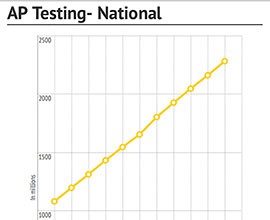Not just the Ivies: Students send AP scores to community colleges
Tuesday, May 5, 2015By Sarah Dinell
WASHINGTON – Advanced Placement exams and community colleges. They go together like… well, they never seemed to go together.
But that may not exactly be the case, according to numbers from the College Board, the organization that administers the AP tests that students across the country started taking this week.
The rigorous high school tests are more often associated with high-achieving students who can boost their grade-point averages or earn college credits through the courses and exams. But College Board data show that 4 to 5 percent of students who take the tests in Arizona regularly ask to have their scores sent to community colleges in the state.
Experts said they were not surprised by the numbers, saying the increasing popularity of community college as an affordable alternative to – or a start on – a four-year college degree is probably what’s behind the practice.
“It doesn’t really surprise me that you have a fair amount of people who send their AP scores to a community college,” said Neal McCluskey, the associate director of the Cato Institute’s Center for Educational Freedom.
“It’s recently been the case that people will look to do their first year or two at a community college because it’s cheaper, and then transfer to a four-year college,” McCluskey said.
Statistics from the College Board show that 1,438 of the 32,673 students who took an AP test in Arizona in 2014 asked to have their scores sent to community colleges in the state.
That’s about 4.4 percent of all Arizona AP test takers, a rate that has remained essentially the same for the past 10 years, according to the College Board.
During that time, the number of students taking the test in Arizona has exploded, from 11,535 in 2004 to 32,673 in 2014, a 183 percent increase. The number sending scores to community colleges increased at about the same rate, growing 177 percent from the 519 who targeted community colleges in 2004.
That steady growth in AP applications to community colleges has come even as the type of community college student has changed, one expert said.
“A lot of people have a vision of community college that it’s older folks, or younger people in high school taking an extra class, but we have more traditional-aged community college students now,” said Catherine Hill, the American Association of University Women’s vice president for research.
“If you look at community college students, about half of them are traditional college-aged students, so 18 to 24,” Hill said.
High school students can take AP tests in a range of subjects, from European history to calculus.
As the number of students taking the test has risen, so has the number of subjects they take tests in. The College Board said the 11,535 students who took an AP test in Arizona in 2004 sat for 19,590 AP tests total. By 2014, the numbers had risen to 32,673 Arizona students sitting for 57,161 exams.
Not surprisingly, the number of test results reported to community colleges has risen at the same time, from 699 in 2004 to 2,049 last year. That’s just under 3.6 percent of all tests taken in the state, the same percentage as 10 years ago.
Lindsey Burke, a Heritage Foundation education fellow, believes people are just becoming more careful before going to college.
“I think a lot of students are looking at the amount of debt that they have to take out and other opportunity costs – the amount of money they’re not earning by delaying entering the workforce – and are having some second thoughts about whether it’s ultimately worth it for them to take out all of this debt,” Burke said.
And debt concerns are part of the reason experts believe community college enrollment may be on the rise.
“For the most part we see a really, really large gap in costs of four-year education versus a community college education,” Hill said. “People are getting part of their degree at the associate level, and then transferring on to four-year programs. It’s a growing path in general.”









